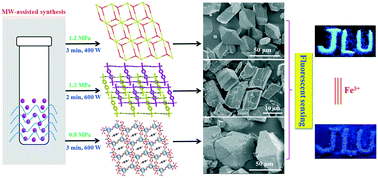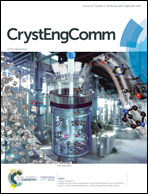Three layer-structured cadmium coordination polymers based on flexible 5-(4-pyridyl)-methoxylisophthalic acid: rapid synthesis and luminescence sensing†
Abstract
Based on flexible 5-(4-pyridyl)-methoxylisophthalic acid ligand (H2L), three layered cadmium coordination polymers, namely [CdL(H2O)]·2H2O (1), [CdL(H2O)(4,4′-bipy)0.5]·H2O (2) (4,4′-bipy = 4,4′-bipyridine), and [CdL(H2O)2]·0.5H2bdc (3) (H2bdc = 1,4-benzene dicarboxylic acid), have been prepared by a rapid microwave (MW)-assisted solvothermal synthesis method. It is noteworthy that the MW-assisted method can effectively accelerate the reaction rate compared with a conventional solvothermal method. 1 exhibits a 2D layer with the quadrangle windows built from dinuclear [Cd2N2O10] SBUs and L2− ligands. 2 shows an interesting two-fold interpenetrated 2D layered structure, in which the 4,4′-bipy ligands link the adjacent sheets constructed from Cd2+ cations and L2− ligands to build a double-layered structure with rhombic windows. For 3, the Cd2+ ions are linked with L2− ligands to form a 2D layer and free H2bdc ligands penetrate into the rhombic windows of the adjacent layers. Moreover, the activated samples of 1, 2 and 3 possess excellent luminescence sensing properties for Fe3+ ions in aqueous solution with high sensitivity and selectivity, respectively.



 Please wait while we load your content...
Please wait while we load your content...